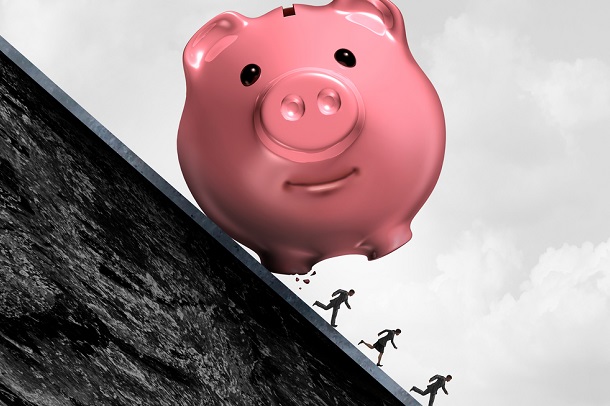 Thestudy illustrates how anxiety is increased by financialworries–just 10 percent of the wealthiest Americans report beingvery anxious about their future. (Photo: Shutterstock)
Thestudy illustrates how anxiety is increased by financialworries–just 10 percent of the wealthiest Americans report beingvery anxious about their future. (Photo: Shutterstock)
The social bargain that many Americans have accepted (if notembraced)—that extremes of wealth and poverty are part of anequation that allows the middle class to live in comfort andwith "enough"—could be breaking down, according to the findings ofa new national survey.
|"Life Experiences and Income Inequality in theUnited States," a report from National Public Radio, theHarvard T. Chan School of Public Health Chan, the Robert WoodJohnson Foundation, surveyed more than 1,800 Americans of differentlevels of household wealth. The findings suggest stark differencesin attitudes between the wealthiest and other groups—and a growingsense of insecurity among middle class households. The study lookedat several areas of inequality—this article will look at generalfindings, while part two will focus on health care issues.
|Related: Geographic inequality pushing low-skill workers outof cities
|"These findings illustrate that adults in the top 1 percenthighest income bracket have dramatically different life experiencesthan those with middle- and lower-incomes," the study said. "Muchhas been written about low-income adults in the U.S., and thesefindings reinforce that adults with lower-incomes face significantfinancial hardships… [but] these findings also raise importantconcerns about the American middle class."
|Different experiences with bills and debt
Not surprisingly, the wealthy are less concerned with unexpectedbills—of the top 1 percent of earners ($500,000+ in income), only 4percent say they would have trouble paying off an unexpected billof $1,000. Twelve percent of high earners ($100,000 to $499,000)reported that such an expense would be a problem. Just over athird, 34 percent, of middle-income Americans ($35,000 to $99,000)said such an expense would be a problem, and 67 percent of thoseearning less than $35,000 said a $1,000 expense would be aproblem.
|For most respondents, the biggest financial challenges were withhealth care bills, but other areas also wereproblematic: middle class households report struggling witheducation bills 30 percent of the time. Education costs were aproblem for 33 percent for low-income families, 23 percent forhigh-income earners, and 12 percent of top-1-percenters.
|Trouble paying credit card bills were not that different forlow-income households and middle-income earners, at 33 percent and31 percent, respectively. Higher-income adults reported troublewith these bills 21 percent of the time, highest earners reportedtrouble with credit card bills 6 percent of the time.
|Lower-income Americans also struggle with more basic needs: 35percent said they have trouble finding an affordable place to live;30 percent reported having trouble paying for food.
|Anxiety and the American Dream
The study illustrates how anxiety is increased by financialworries. Just 10 percent of the wealthiest Americans report beingvery anxious about their future. For higher-income respondents, thenumber was 14 percent. For middle-income Americans, 19 percent saidthey are very anxious about the future; among lower-incomeAmericans, that number is 29 percent.
|Even with the current amount of income inequality, manyAmericans said they believe the American Dream is still in reach.But again, much depends on where the respondents are startingout.
|When asked about achieving the American Dream, nearlythree-quarters of the highest-income adults, 73 percent, said theyhave achieved the American Dream, with 24 percent saying they areon their way to achieving it. More than half of high-income adults(54 percent) said they have achieved the American dream, with 39percent saying they are on their way.
|Among middle class respondents, 37 percent said they haveachieved the American Dream, 45 percent said they are on their wayto achieving it, and 15 percent said they viewed it as out ofreach. Among lower-income adults, 20 percent said they haveachieved the American Dream, 36 percent said they are on their wayto achieving it, and 40 percent say it is out of reach forthem.
|And despite the financial pressures facing many Americans, a biggovernment solution is not their first choice: less than 50 percentof any income group said income inequality should be a top priorityfor the next President and Congress.
|However, the survey also found a majority of Americans supporthigher taxes on the wealthy. Nearly half of the top 1-percentearners, 48 percent, supported higher taxes on very wealthyAmericans. High-income earners supported higher taxes on the verywealthy at 53 percent, and middle-income and lower-income adults,55 percent and 61 percent, respectively, said very wealthyAmericans should pay more in taxes than they do now.
|Read more:
- Optimism falling among middle class, women as fearsof recession rise
- Aging exacerbates economicinequality
- Fed's Brainard says middle-class squeeze posesrisks to economy
Complete your profile to continue reading and get FREE access to BenefitsPRO, part of your ALM digital membership.
Your access to unlimited BenefitsPRO content isn’t changing.
Once you are an ALM digital member, you’ll receive:
- Critical BenefitsPRO information including cutting edge post-reform success strategies, access to educational webcasts and videos, resources from industry leaders, and informative Newsletters.
- Exclusive discounts on ALM, BenefitsPRO magazine and BenefitsPRO.com events
- Access to other award-winning ALM websites including ThinkAdvisor.com and Law.com
Already have an account? Sign In
© 2024 ALM Global, LLC, All Rights Reserved. Request academic re-use from www.copyright.com. All other uses, submit a request to [email protected]. For more information visit Asset & Logo Licensing.








